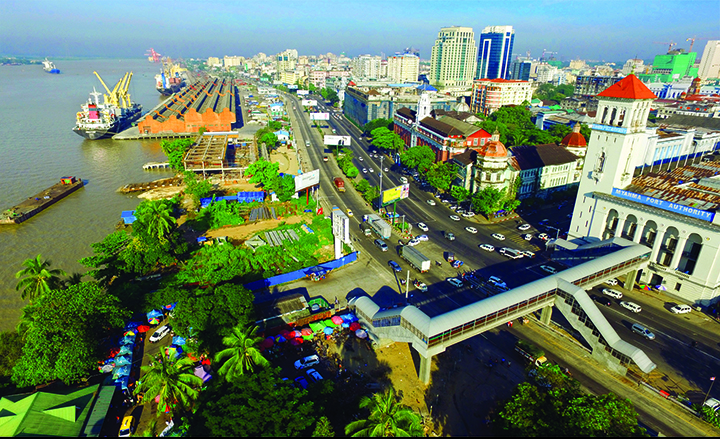Myanmar now is gaining acceleration in its move towards reaching the age of robust economic growth. The new economic formation began in 2017, under the Myanmar Companies Act. The country is also writing partnership law in accord with the prevailing situation. After undergoing a step-by-step reform process, the Union of Myanmar Investment Law (2016) was enacted, and the country has been attracting foreign direct investment (FDI) through it.
The most important part of the economic strategy is the warmer international relations Myanmar has been enjoying since 2016. This positive trend has paved the way for the establishment of foreign banks and insurance companies in the country, which can be said the dawn of the new economic age. We hope that we will certainly reach the stage of welcoming international capital flows.
Projects to shape the economy
The Myanmar Sustainable Development Plan–MSDP (2018-2030) is being implemented through various modules including the public-private partnership (PPP), State budget allotments, development aids, and other financial assistance.
Public-private partnership (PPP) is a funding model for a public infrastructure project such as a new telecommunications system, airport or power plant. The public partner is represented by the government at a local, state and/or national level. The private partner can be a privately-owned business, public corporation or consortium of businesses with a specific area of expertise. Different models of PPP funding are characterized by which partner is responsible for owning and maintaining assets at different stages of the project. Examples of PPP models include:
1. Build-Own-Operate (BOO): The private-sector partner finances, builds, owns and operates the infrastructure component in perpetuity. The public-sector partner’s constraints are stated in the original agreement and through on-going regulatory authority.
2. Build–operate–transfer (BOT) or build–own–operate–transfer (BOOT): It is a form of project financing, wherein a private entity receives a concession from the private or public sector to finance, design, construct, own, and operate a facility stated in the concession contract.
3. Build-Transfer-Lease (BTL ): A lease P3 involves the public owner leasing a facility to a private firm. The private company must operate and provide maintenance for the facility per specified terms, including additions or a remodeling process.
4. Under a build-transfer-operate P3, the private partner builds the facility and transfers it to the public partner. The public partner then leases operation of the facility to the private party under a long-term lease agreement.
5. Operation and maintenance (O&M): With an operation and maintenance P3, the private component of the partnership operates and maintains the project, while the public agency acts as the owner of the project. Examples of these contracts include bridges and tollways. Ongoing maintenance may provide revenue for the private party through tolls or other fees paid through public use.
6. PPP also involves Design-Build-Operate and Design-Build-Finance-Operate-Transfer models. Design build-operate P3s are similar to design-build P3s but include ongoing operation and maintenance of the property facility or project by the private party. The public partner acts as the owner of the installation and provides the funds for construction and operation. If the private partner operates the project only for a limited time before the facility is transferred to the public partner, the arrangement is known as a design-build-operate-transfer agreement.
PPP centre
The aim of forming the PPP Center is to promote the capacity of government organizations in identifying, inviting, implementing, monitoring and supervising public-private projects.
Financial support can come from the State budget or government bonds for PPP projects to run economically. Other possible means such as development aids and non-financial services and movable/immovable property are taken into consideration. PPP Center adopts definite principles for government investment. If there are no specific prescriptions, the Equity Ratio will not be less than 30% of a 50-million-dollar investment, and Debt to Equity Ratio shall not be lower than the 20% of the US 50 million and above. If the government financial support is received this amount is excluded from the investment value in calculating Debt to Equity Ratio. In making Environmental Impact Assessment and Social Impact Assessment of the PPP projects, all the existing laws, with, 2012 Enviromental Conservation Law as the foundation, and rules, regulations and directives in force must be observed. PPP projects can get share loans or foreign loans in accord with the provisions of Foreign Currency Management Law (2012).
Stipulations of the agreement
In reaching agreements that are related to the PPP project, the party to the agreement can adopt the Availability Payments, BOO, BOT, BTL.BTO, O & M or other PPP models to share the cost of possible risk.
The Governing Law of the agreements should be the existing law of the Republic of the Union of Myanmar. Arbitration Rules can include international arbitration rights, which are in conformity with the 2016 Arbitration Law of the Republic of the Union of Myanmar and the provisions of the agreements. The organizations concerned must state the relinquishment of their Wavier of Immunity from Jurisdiction and Execution by Statue in the agreements in implementing the PPP projects. The PPP has stood as a new model in today’s economic system. There are many examples of rapid economic progress gained by the developed countries for the broader use of the model.
Economic reform
Myanmar is strictly complying with the Standard Operating Procedures while carrying out economic reforms, with might and main. Without coordination, investments will not be meaningful. We must take the economic thrust from both the internal and external sources. So, coordination is a must in the economic sector. Placing both the Horizontal Coordination and Vertical Coordination in the right position is a new model that will surely benefit the PPP. Economic management, the rule of law, systematic budgeting system and increase in investment are basic requirements for economic growth of a nation.
(Translated by TMT)


